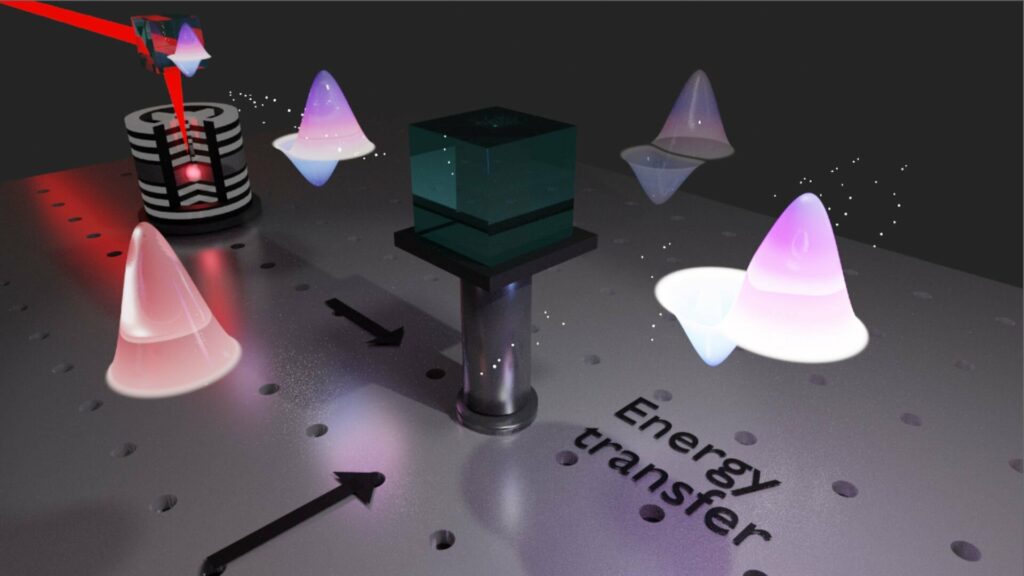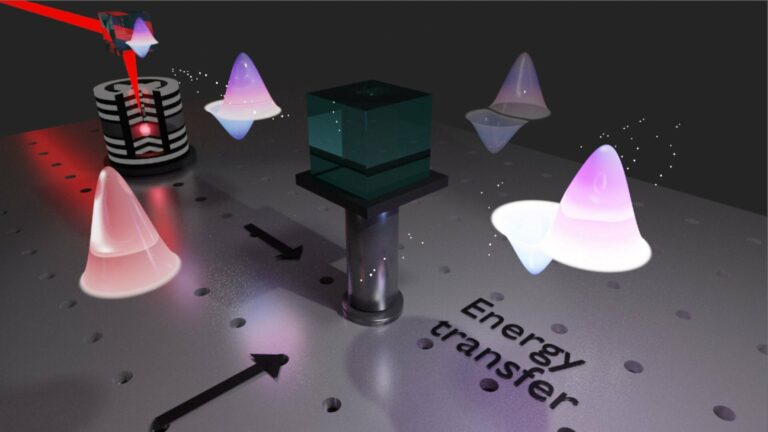Exploring Quantum Energy Exchange: Investigating Light Fields and a Quantum Emitter
A new study in Physical Review Letters illuminates the intricacies of energy exchanges within bipartite quantum systems, offering profound insights into quantum coherence, pure dephasing effects, and the potential impact on future quantum technologies.
In quantum systems, the behavior of particles and energy transfer are governed by probability distributions and wave functions, adding layers of complexity to the understanding of energy exchanges.
The exploration of energy exchanges in quantum systems inherently involves tackling the complexities arising from quantum decoherence and the scales at which quantum systems operate, introducing sensitivity.
Despite these challenges, studying energy exchanges in quantum systems is vital for advancing quantum technologies and understanding the fundamental aspects of quantum mechanics.
The researchers aim to bridge the gap between theoretical predictions and experimental observations in quantum optics and thermodynamics. By exploring energy exchanges within bipartite quantum systems, the study strives to provide a comprehensive framework for understanding the intricate dynamics at play.

“From my Ph.D. and the beginning of my academic journey, I have built a background in experimental quantum optics, which I kept when switching to theory. I got involved in quantum thermodynamics ten years ago and have been working on bridging gaps between the two fields ever since. These results represent a beautiful concretization of these efforts,” Prof. Alexia Auffèves, a visiting research professor at the Center for Quantum Technologies in Singapore and a co-author of the study, told Phys.org.
Unitary and correlation energy
Bipartite systems refer to quantum systems composed of two separate entities or subsystems, often exhibiting entanglement and quantum superposition. Energy exchanges within these systems, such as those studied in the research, provide insights into quantum dynamics.
In the words of Prof. Auffèves, the theoretician behind the study, “When two quantum systems are coupled but otherwise isolated, they can exchange energy in two ways: either by exerting a force on each other or by getting entangled. We dub these energy exchanges ‘unitary’ and ‘correlation,’ respectively.”
This distinction highlights the dual nature of energy interactions within bipartite systems, with unitary energy involving forces and correlation energy arising from entanglement.
Understanding the dynamics within these systems is crucial for advancing quantum mechanics and developing applications like quantum computing. In particular, bipartite systems are essential components in quantum gates and algorithmic operations, forming the foundation for emerging quantum technologies.
Prof. Auffèves further elaborates on the research focus, “We have studied experimentally and theoretically these energy exchanges, first between a qubit and a light field, and second, between two light fields coupled by a beam-splitter.”
Part 1: Spontaneous emission of a qubit
In the first part of the study, the researchers focused on the spontaneous emission of a qubit, represented by a quantum dot. Quantum dots are nanoscale semiconductors exhibiting quantum mechanical properties.
It is often referred to as an artificial atom because, like atoms, it has a discrete energy level. The quantum dot was placed in a reservoir of empty electromagnetic modes, meaning there were no disturbances or interactions from electromagnetic fields.
“Former theoretical results obtained in my group predict that the amount of unitary energy transferred to the vacuum field should be proportional to the initial quantum coherence of the qubit,” explained Prof. Auffèves.
In simple terms, when the qubit is initially prepared in an equal superposition of ground and excited states, the transfer of unitary energy to the vacuum field is maximized.
In such a scenario, the transferred unitary energy equals half of the total energy released by the qubit. On the contrary, if the qubit is initially inverted, only correlation energy gets transferred to the field. This dependency on the qubit’s initial quantum state highlights the intricate nature of energy transfers in quantum systems.
The results of the first part were precisely what the researchers were expecting. As Prof. Auffèves highlighted, “The experiments reported in the paper beautifully meet our expectations. They involve as a qubit a quantum dot coupled to a leaky semi-conducting microcavity.”
“The unitary energy received by the field, i.e., the energy locked in the coherent component of the emitted field, is measured using a homodyne setup. The level of experimental control is such that the unitary energy almost reaches the theoretical bound, whichever is the initial state of the quantum dot.”
This means the team could accurately measure and understand how the quantum field exchanges energy during this process.
Part 2: Coupling two light fields
For the second part, the researchers examined energy exchanges between the emitted light field and a reference coherent field. Both fields were intricately coupled using a beam-splitter, a device commonly used in quantum optics for manipulating the paths of light beams.
The study involved a quantum system reminiscent of linear photonic quantum computing, incorporating interferences of light fields through beam splitters.
“Unlike the first case, this study was uncharted territory. This triggered an exciting dialog between theory and experiment to extend our concepts of unitary and correlation energies to this new situation and study new behaviors and patterns,” said Prof. Auffèves.
The quantitative analysis revealed a significant finding: the unitary energy transfers were shown to be dependent on the purity and coherence of the emitted field. This implies that the characteristics of the light field, specifically its purity and coherence, play a crucial role in determining the nature and magnitude of unitary energy exchanges.
“In both cases, we find that the unitary energy (respectively, correlation energy) received by a light field is equal to the energy change of the coherent component (respectively, incoherent component) of this field,” explained Prof. Auffèves.
Quantum applications and beyond
“The framework we have started to build within this paper could play a key role in future energetic analyses of photonic quantum computing,” said Prof. Auffèves.
Understanding energy and entropy exchanges is crucial for enhancing processes like entanglement generation and quantum gates. Managing pure dephasing at higher temperatures, as revealed in the study, becomes vital for efficient unitary energy exchange, which is needed to implement quantum gates.
Speaking of future research, Prof. Auffèves wants to focus on the fundamental side of things by exploring quantum optics with energetic and entropic tools.
“For example, by extracting optical signatures of irreversibility, or reciprocally, detecting the quantumness of a field with energetic figures of merit. On the practical side, it will be important to assess if and how the concepts of unitary and correlation energy impact the energy cost of macroscopic, full-stack quantum technologies,” she concluded.
This article is republished from PhysORG under a Creative Commons license. Read the original article.
Do not forget to share your opinion with us to provide you with the best posts !




0 Comments